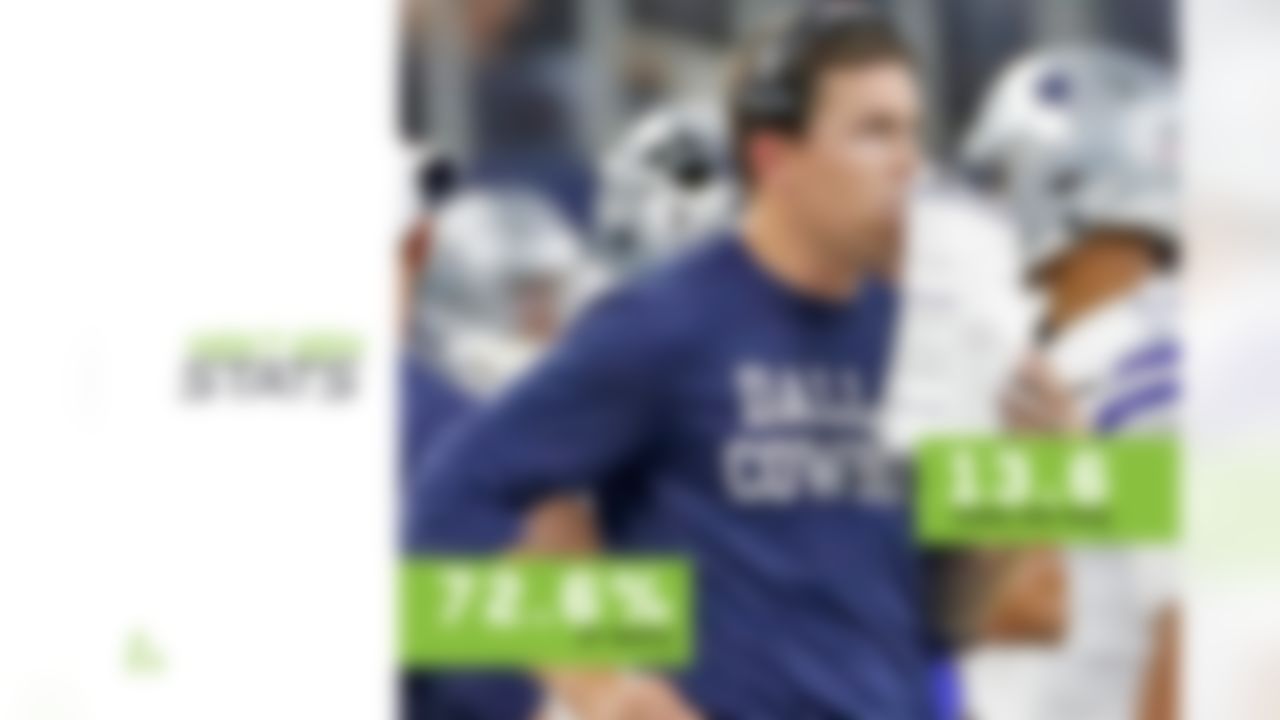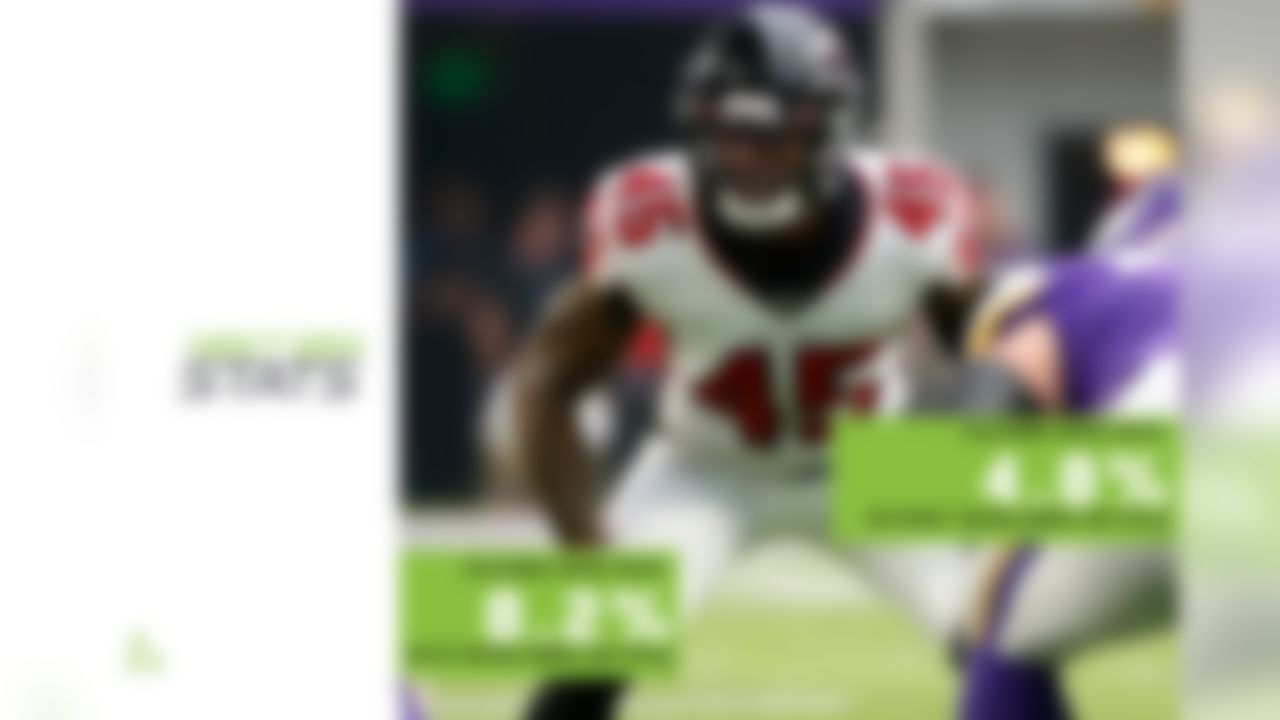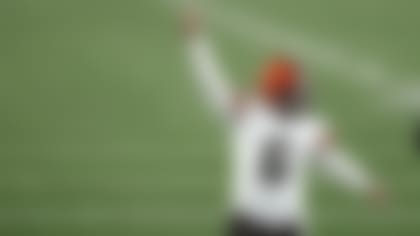NFL Photos | NFL Photography Gallery | NFL.com
Next Gen Stats
Next Gen Stats: Compelling figures that could shape Week 2
Want to see the numbers behind the numbers? NFL Research's Keegan Abdoo dives into a fresh batch of Next Gen Stats and identifies figures that are helping to shape the NFL narrative entering Week 2 of the 2019 season.

The Vikings' offense is taking on the personality of defensive-minded head coach Mike Zimmer, who insisted that his team pound the rock coming into the 2019 season. Offensive coordinator Kevin Stefanski took over in Week 15 last season, and began the transition to a more run-oriented offense over the last few weeks of 2018. The transformation was on full display in Week 1 vs. Atlanta, as the Minnesota offense aligned under center on 41 of their 49 offensive plays (83.7 percent) and ran 78.0 percent of the time when under center (32 of 41 plays). Despite this extreme rushing tendency, the Vikings averaged 5.1 yards per rush from under center in Week 1. Even when they aligned in shotgun, the Vikes ran 75.0 percent of the time (6 of 8 plays). Look for Minnesota to continue this ground focus in Week 2 against a Green Bay defense that allowed 3.1 yards per rush to the Bears in Week 1.

Lamar Jackson started the season with a bang in the Ravens' rout of the Dolphins. Almost all of Jackson's production in Week 1 came when throwing inside the tackle box, where he completed 16 of 17 attempts for 321 yards and five TDs. Although Jackson is known for his electric athleticism, he has excelled inside the tackle box in his young NFL career. Jackson has averaged nearly twice as many yards per attempt inside the tackle box (9.3) than when throwing outside the tackle box (4.7). Jackson also gets rid of the ball much quicker inside the tackle box (2.51 seconds time to throw compared to 4.70 seconds outside) and has an 11:2 TD-to-INT ratio when he stays inside (0 TD, 1 INT outside). Credit OC Greg Roman for adapting the scheme to Jackson's strengths, as the 22-year-old QB threw 85 percent of his passes inside the tackle box in Week 1. That's a big increase from his rate last season (72.4 percent), which was the lowest figure among all quarterbacks with 150-plus pass attempts.

In the first game since Rob Gronkowski's retirement, the Patriots eschewed the TE position and heavily featured 20 personnel groupings (2 RB, 0 TE, 3 WR). They employed 20 personnel on 23 offensive plays, the most by any team in a game since 2016. To put this in perspective, New England used 20 personnel in 2017 and '18 on 18 plays combined. Overall the Pats had two RBs on the field on 48 of 67 plays (71.6 percent), and their play calling contrasted heavily based on which backs were on the field. If James White (28 of 32 snaps were passing plays) or Rex Burkhead (22 of 30) were on the field, it was a major tip-off that Tom Brady was poised to throw. Conversely, 17 of Sony Michel's 22 snaps and 21 of James Develin's 30 snaps were runs. These tendencies carry over from 2018, when Michel (74.8 percent) and Develin (69.4 percent) ranked first and second in run-play percentage among 231 skill-position players with 300-plus snaps, and James White (22.6 percent) ranked 220th.

There's a new sheriff, I mean, play caller in Dallas, and so far these Cowboys have been rejuvenated. Kellen Moore increased the Cowboys' 11 personnel (1 RB, 1 TE, 3 WR) usage in Week 1, employing the grouping on 72.6 percent of plays, up from 63.4 percent of plays in all of 2018. So far the increase has been fruitful, as Dallas' offense averaged 8.9 yards per play, a 3.4-yard increase from last season (fourth-largest increase in NFL). The Cowboys were most effective using 11 personnel through the air, averaging 13.6 yards per pass, the second-most yards per pass in 11 personnel in Week 1. Much of that can be attributed to how Moore's scheme has created open throwing windows for Dak Prescott downfield. Prescott targeted tight windows on 11.1 pct of passes traveling 10-plus air yards in Week 1, less than half his rate in 2018 (28.7 percent). As a result, Prescott dominated throwing the ball more than 10 air yards down the field, completing 8 of 9 attempts for 243 yards and three scores.

With a revamped OL and new coaches, Jacoby Brissett's second go-round taking over for Andrew Luck to run the Colts offense has started off great. Much like Frank Reich did last season for Luck, he has created a scheme that gets the ball out quickly, limits pressure and targets the most efficient area of the field (the seams). Brissett dropped his time to throw (2.89 seconds in 2017, 2.33 in Week 1) just like Luck (2.88 seconds in 2016, 2.63 in '18). Both Brissett (36.3%, fourth) and Luck (42.3%, first) had top-five pressure rates in their season as the Colts starter before Reich. Brissett was only pressured on four of his 29 dropbacks in Week 1 (13.8%), and Luck almost cut his pressure rate in half (22.1%) in '18. Brissett threw 66.7% of his attempts down the seams in Week 1, up from 50.7% in '17. You can expect this continue, as Luck threw 56% of his attempts down the seams in '18.

The 49ers invested heavily in their pass rush this offseason, drafting Nick Bosa and trading for Dee Ford. They've seen immediate returns, as Bosa and Ford terrorized an overmatched Bucs OL in Week 1. Both Bosa (34.8%, first) and Ford (24%, fifth) ranked among the top five in disruption rate in Week 1 (min. 20 pass rushes). Disruption rate, or the percentage of pass rushes where a defender has a pressure (less than 2 yards of separation from the QB when he releases the ball) or hurry (less than 1.5 yards of separation at any point before the QB passes), is a more comprehensive picture of a pass rushers effectiveness that NGS is rolling out this season. Ford forced six turnovers from pressure in 2018, one fewer than the entire 49ers defense (seven total takeaways). Ford already racked up one turnover from pressure this season, as he and Bosa both pressured Jameis Winston on Ahkello Witherspoon's 25-yard pick-six that sealed the win.

Missing 10 games due to injury in 2018, Deion Jones' absence turned out to be monumental for the Falcons' pass defense. Since 2018, with Jones on the field, the Falcons have created pressure at a higher rate (31.5% with Jones, 28.3% without), allowed 2.1 fewer yards per pass attempt (6.2 with, 8.3 without) and yielded fewer passing TDs per attempt (3.5% with Jones, 6.9% without). Although not an elite pass rusher himself (Jones has generated just three pressures on 81 pass rushes since 2018), Jones' elite coverage ability forced opposing QBs to hold onto the ball for longer (2.86 seconds time to throw with Jones, compared to 2.64 seconds without). This has given his pass-rushing teammates more opportunity to take down the quarterback. With Jones on the field for the Falcons, the team has sacked opposing QBs nearly twice as often (8.2% vs. 4.8%) than without him. It's safe to say that the Falcons are a completely different defense with their leader healthy.











